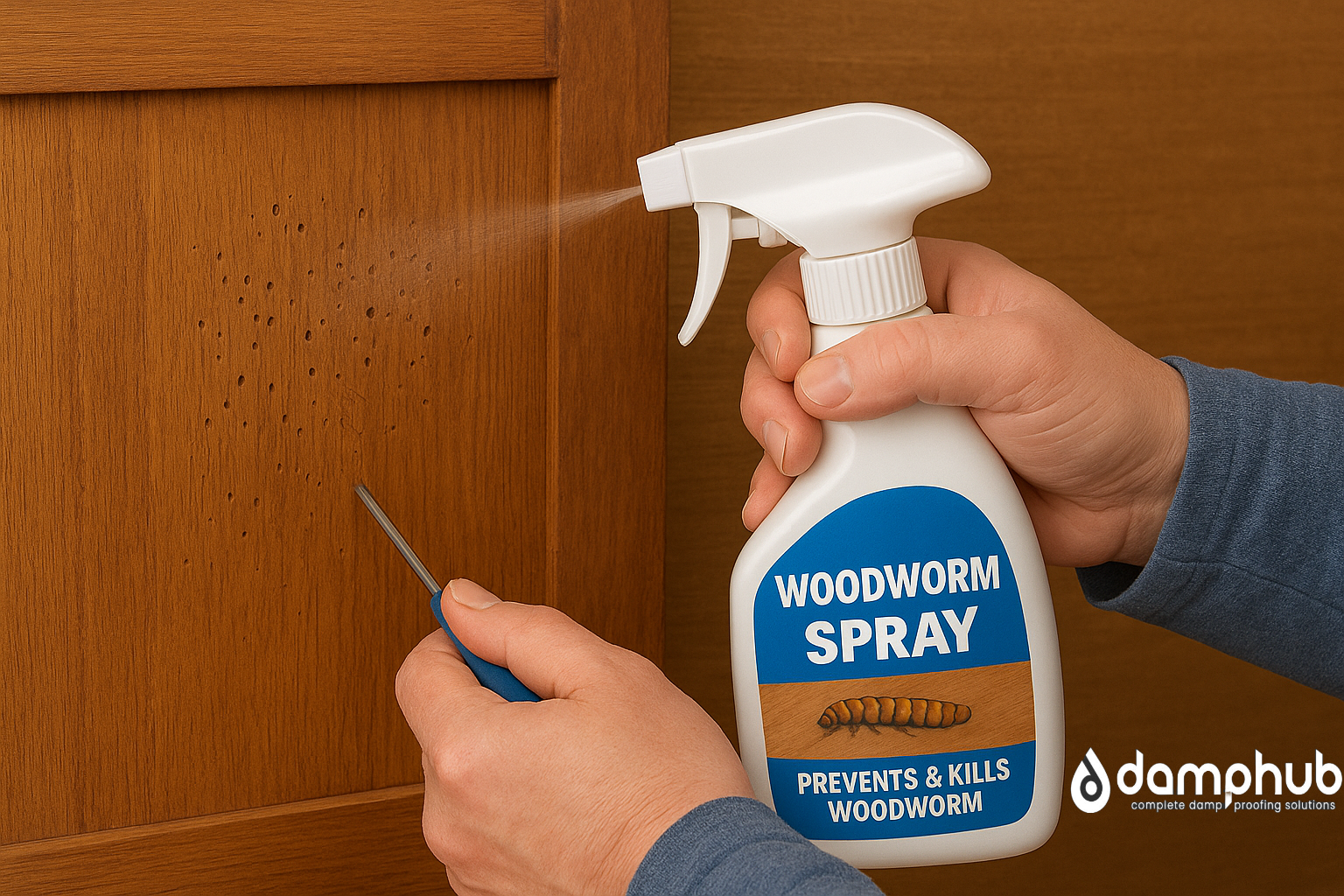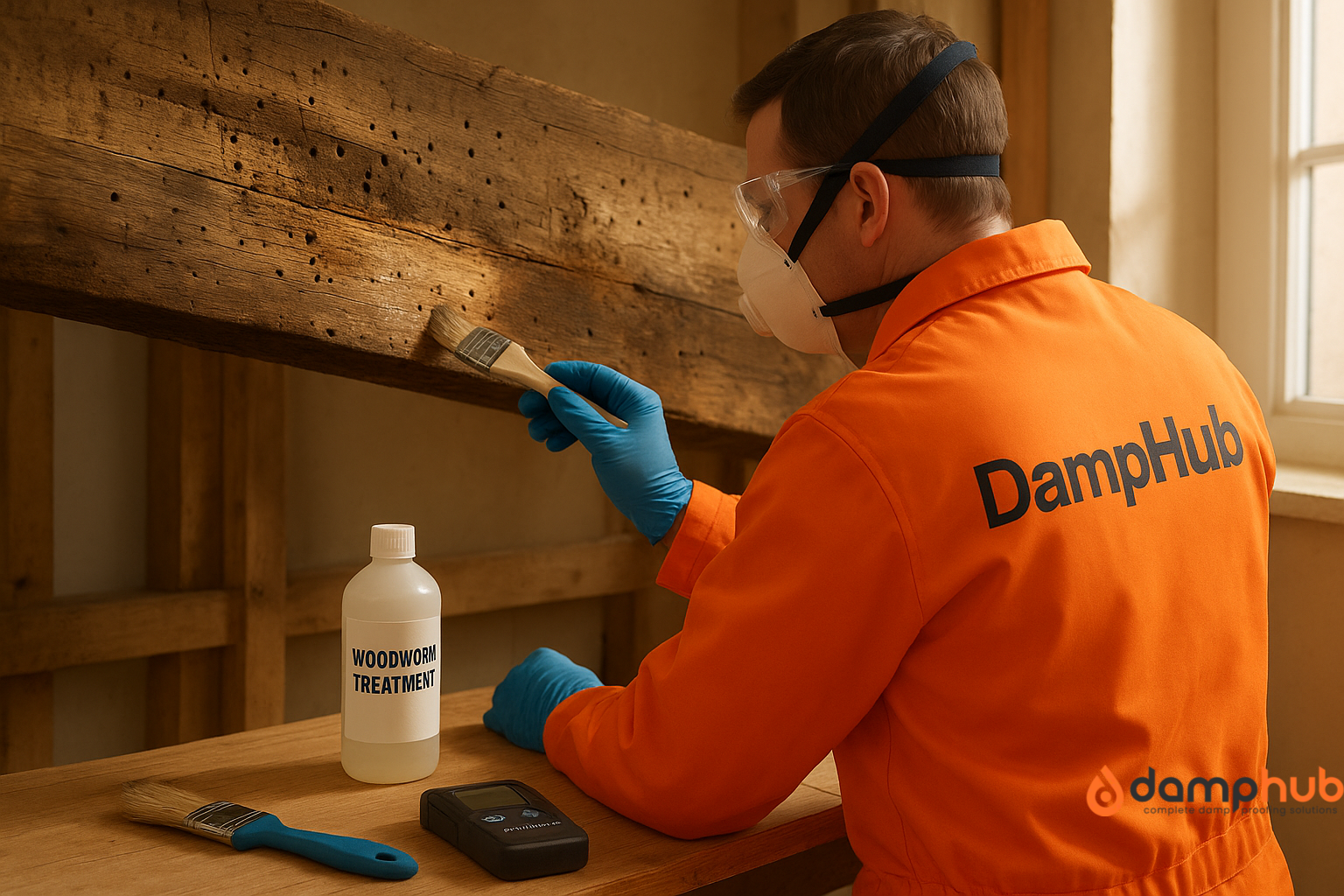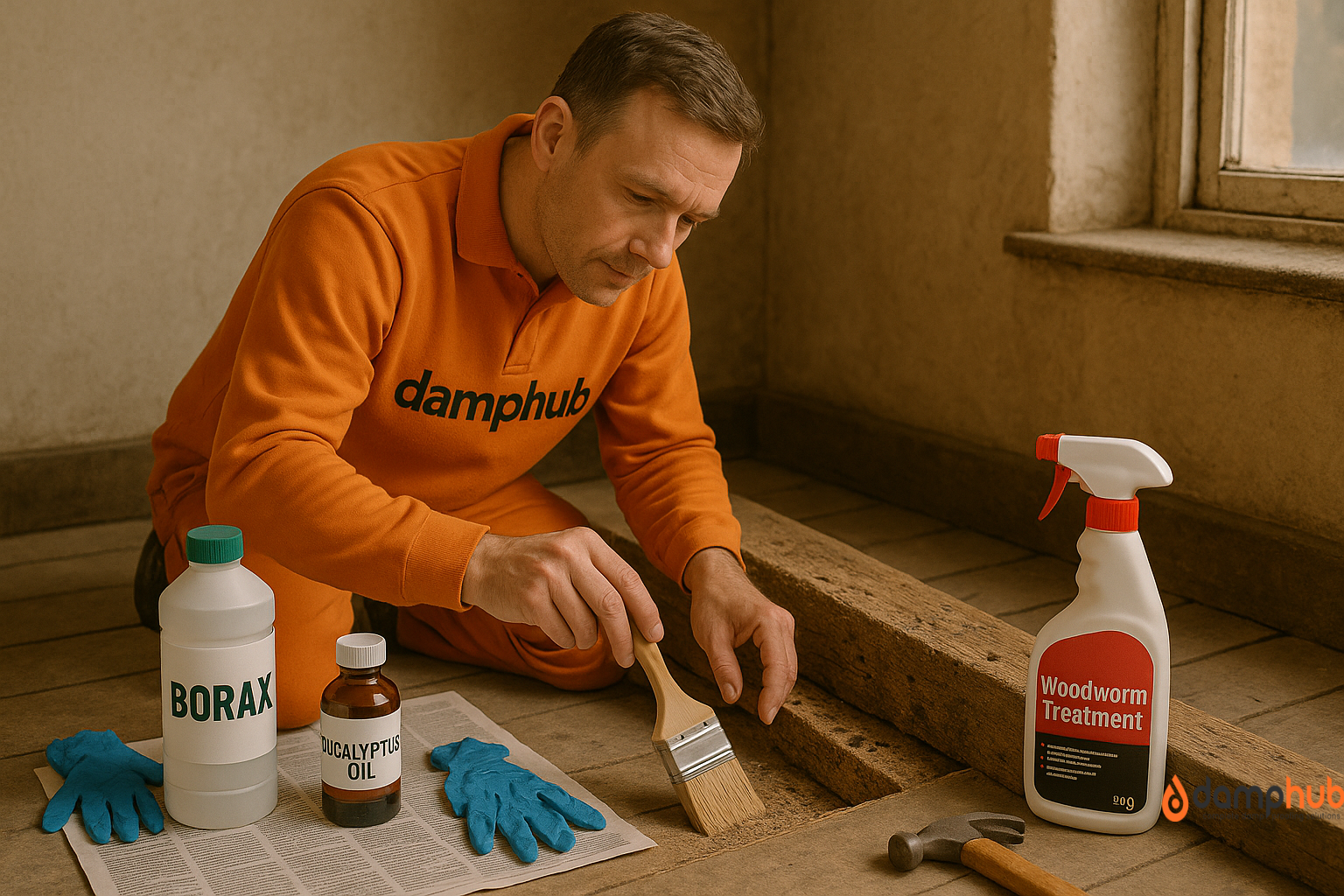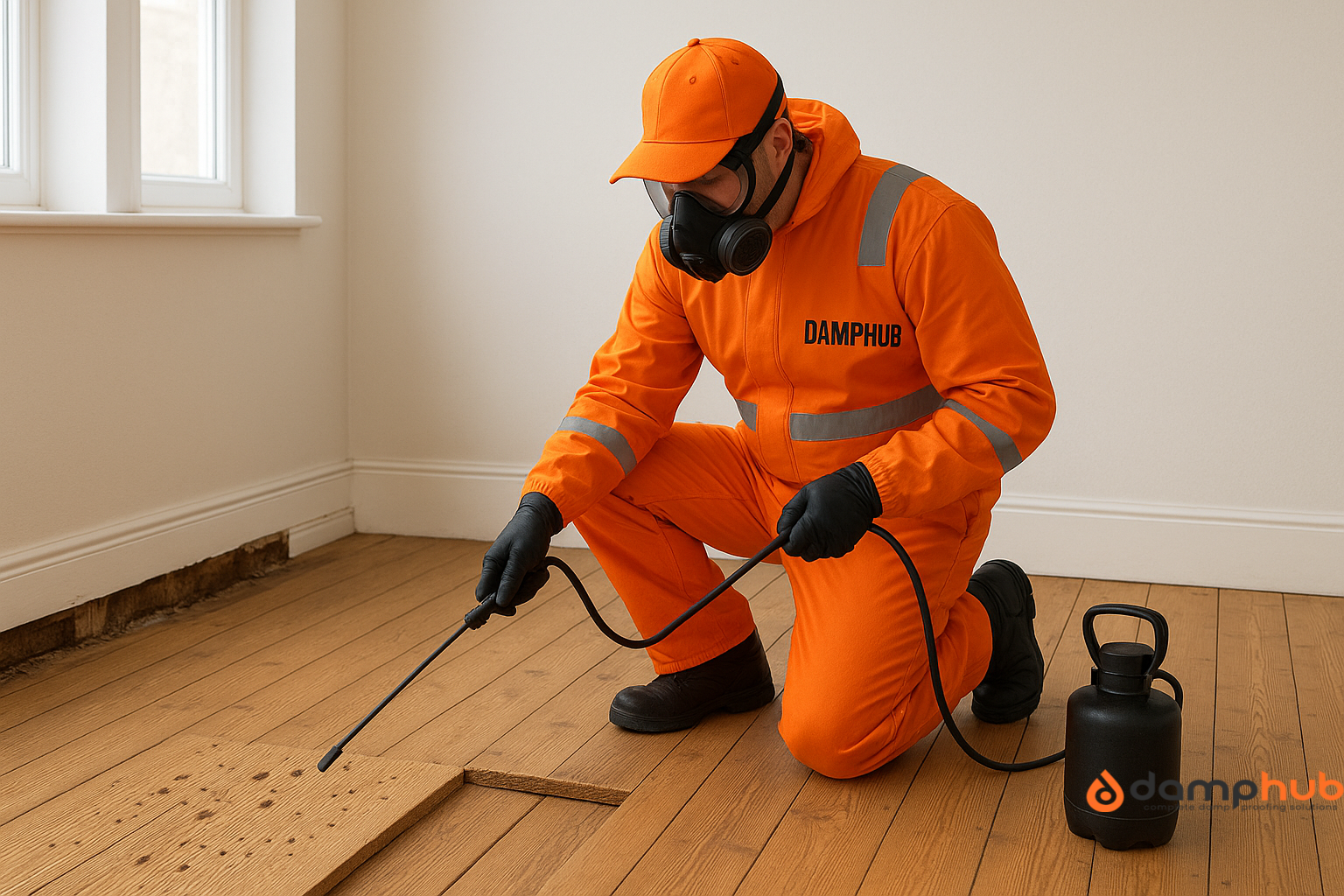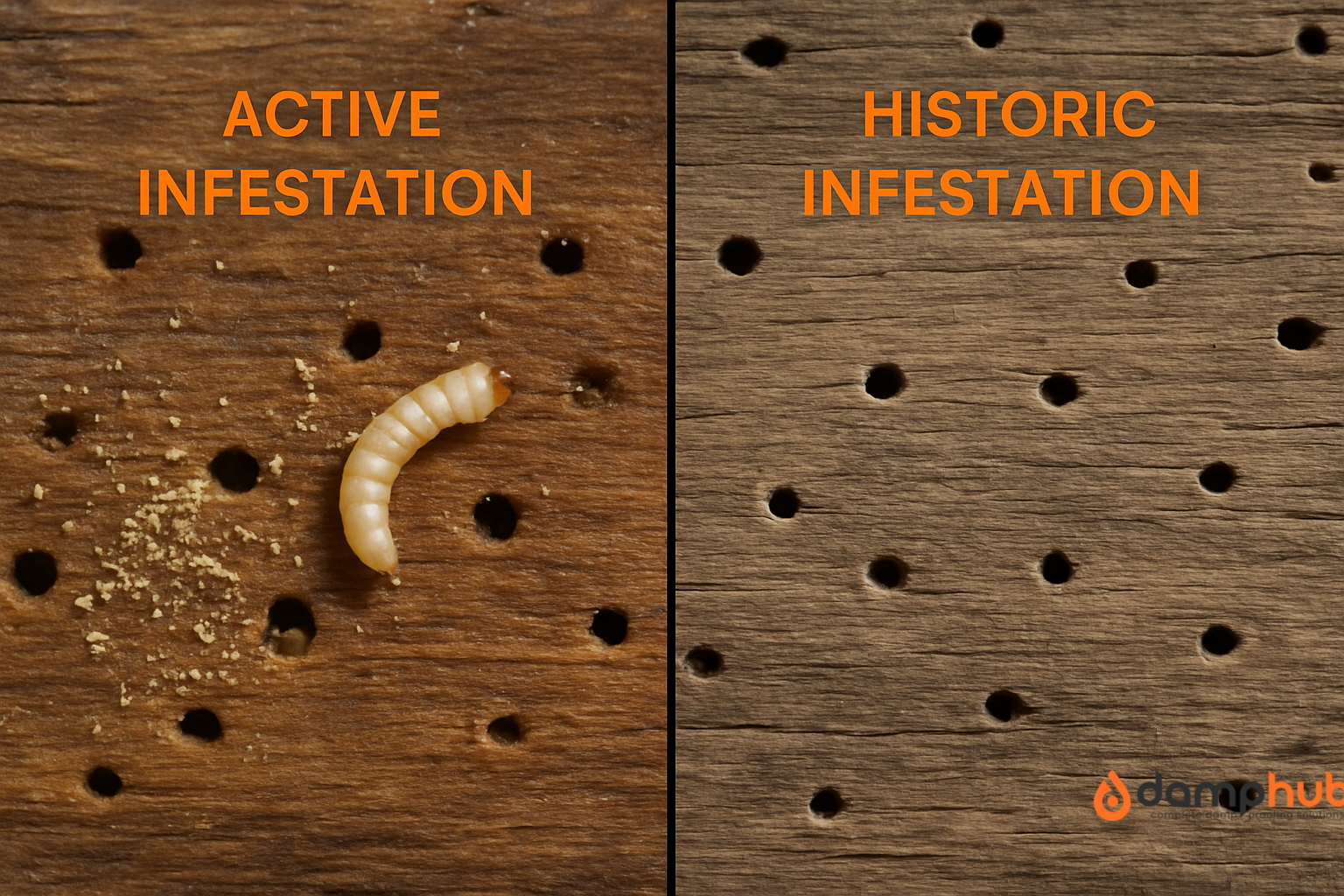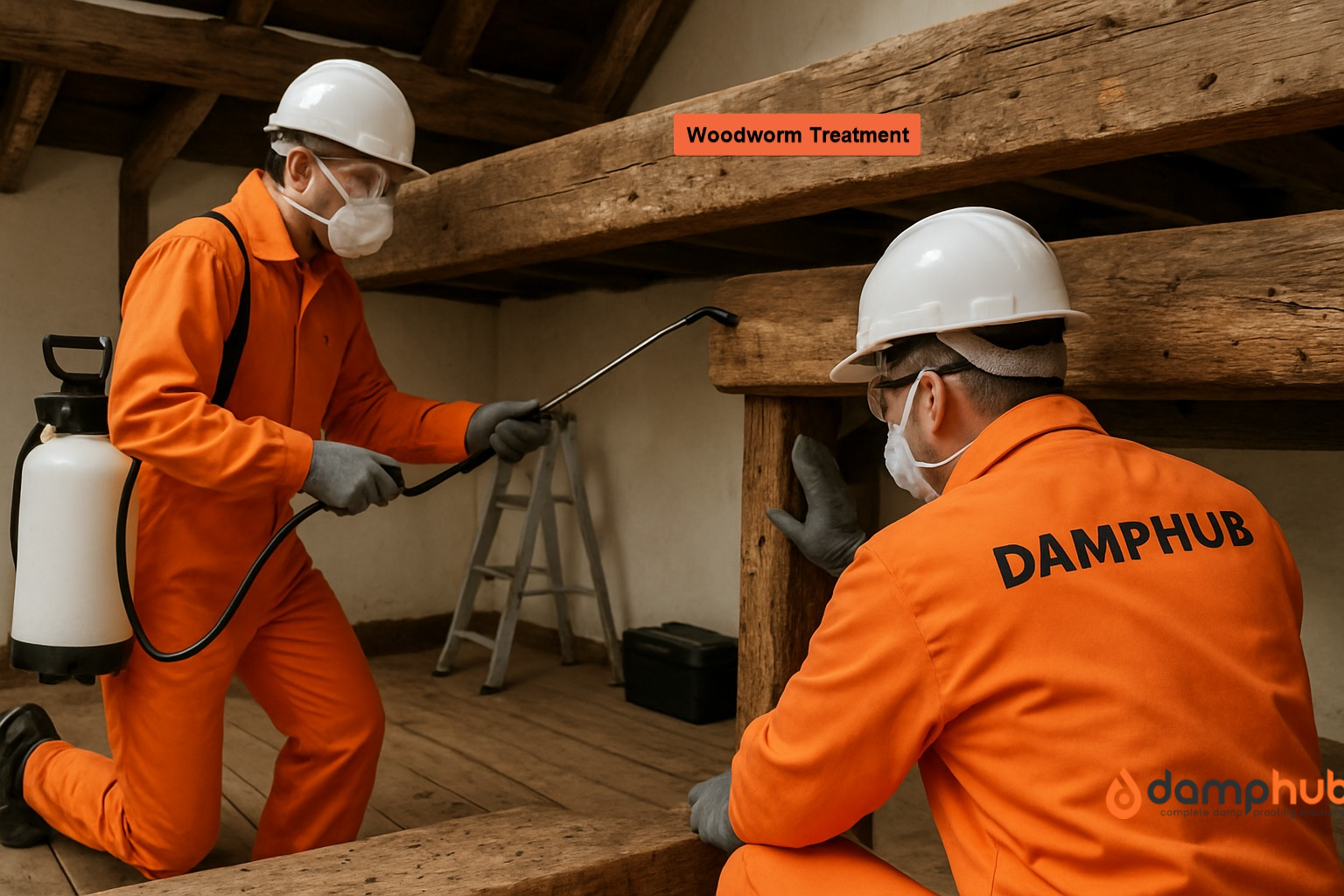
After discovering the signs of a woodworm infestation, the one thing you’ll want is to get rid of them — fast. And it’s easy to see why. If you’re spotting holes, dust, or even the beetles themselves, one thing’s certain: the damage has been happening for a while.
At this point, it’s not just about killing the bugs — it’s about dealing with the damage they’ve already done. Unless you’re a specialist, that usually means bringing in the pros.
And that’s when the big question hits: what will woodworm treatment cost?
If you wish to know your potential costs, this guide will walk you through the typical woodworm treatment costs across the UK, the key factors that affect them, and whether going the DIY route is a bargain or just a bigger risk.
Read on as we guide you through. But first, check out our post on “What Does Woodworm Look Like?” to make sure we’re on the same page.
How Much Does Professional Woodworm Treatment Cost
The costs of treating woodworm usually vary based on various factors, as we explain below:
(1) Woodworm Treatment Costs Depending on the Extent of Infestation
The number one factor that determines the cost of eradicating a woodworm infestation is the size of the damage caused. Bigger damages cost more to fix than smaller damages. Here is the full breakdown:
Small-Scale Jobs — One Room or a Few Beams
If you’ve caught the woodworm infestation early or it’s confined to a small space, you’re looking at:
- £150–£350 for basic spray treatment.
- This typically covers inspection, applying treatment to the affected timber, and basic clean‑up.
- The work might take 1–3 hours, so labour costs stay reasonable.
Medium Jobs — One or Two Average‑Sized Rooms
For woodworm infestations affecting more than just a couple of beams:
- The average cost is £350 to £700.
- This covers treatment for the main visible timber and any accessible hidden areas like joists under the floorboards.
- Time on site is usually half a day.
Large-Scale Jobs — Multiple Rooms or Widespread Beams
If your infestation covers several rooms or a large property:
- Expect £700–£1,500+.
- Larger homes have more timber, so more product, more labour, and more time are required.
- In older properties, treatment often involves loft timbers, ground-floor joists, and sometimes outbuildings.

Quick Woodworm Treatment Cost Table Based Infestation Extent
Quick Cost Table — UK Professional Woodworm Treatment
| Job Size | Typical Price Range |
|---|---|
| One beam / small patch | £150 – £200 |
| Small room | £200 – £350 |
| Medium room | £350 – £700 |
| Large room / multiple rooms | £700 – £1,200 |
| Large property (widespread issue) | £1,200 – £1,500+ |
So, before we even get into extras, you can see how easily the bill can range from £150 for a small job to over £1,500 for a large one. And that’s just for treatment — not repairs.
(2) Woodworm Treatment Cost Based on Timber Accessibility
You might think, “It’s just a bit of spraying — how hard can it be?” But if the affected wood is hidden away, things get more complicated.
- Easy access: Beams in an open loft or exposed timber in a room — quick to treat. No extra costs.
- Hard access: Joists under floorboards, beams behind walls, or tight crawl spaces. May add £100–£300 in extra labour time.
- Very hard access: Beams above high ceilings or in awkward roof spaces needing scaffolding. Access costs alone can add £300–£700.
Why it matters: Contractors work more slowly in awkward areas, and in some cases need to bring in extra equipment or dismantle flooring to get to the problem.
(3) Woodworm Treatment Costs Based on Type of Woodworm
There’s not just one kind of wood‑eating beetle. In the UK, the most common are:
- Common furniture beetle – easiest to treat, cheapest.
- Deathwatch beetle – harder to treat, usually requires injections or deeper treatments.
- House longhorn beetle – rare in the UK but destructive and costly to treat.
If you’ve got deathwatch beetle or house longhorn beetle, treatment costs can double, especially if structural damage means timber has to be replaced.

(4) Woodworm Treatment Costs Based on Treatment Method Required
Not all woodworm infestations can be solved with a quick spray. If the larvae have burrowed deep into the timber, you’ll need a stronger, more invasive woodworm treatment.
- Surface spray treatment: Cheapest, around £3–£5 per square metre.
- Injection treatment: Drilling small holes into timber and injecting insecticide; adds £5–£10 per metre of drilling.
- Fumigation: For large‑scale or severe infestations, £1,000–£2,500+ depending on property size.
Woodworm Treatment Method Costs
| Treatment Method | Typical Cost | What’s Involved |
|---|---|---|
| Surface spray treatment | £3 – £5 per m² | Cheapest method; applies insecticide to exposed surfaces to kill active beetles and larvae near the surface. |
| Injection treatment | +£5 – £10 per metre drilled | Small holes drilled into timber, insecticide injected to reach larvae deeper inside. |
| Fumigation | £1,000 – £2,500+ | Whole‑property gas treatment for severe or large‑scale infestations; penetrates all areas. |
(5) Woodworm Treatment Costs Based on Age and Type of Property
Older properties tend to have more exposed timber — beams, joists, floors, lofts — and those timbers are often softer, more porous, and more vulnerable.
Victorian and Edwardian homes are also more likely to have hidden timber that’s tricky to get to.
A modern house with minimal timber could cost 40–50% less to treat than a large period home.
(6) Woodworm Treatment Costs Depending on Regional Labour Rates
Where you live matters.
- London & South East: Highest labour rates — treatments often cost 10–25% more than the UK average.
- Rural areas: Slightly cheaper, though travel time for contractors may add a small premium.
- Scotland, North East, Wales: Often lower labour rates — sometimes £50–£100 cheaper per job.
(7) Woodworm Treatment Costs Based on Need for Repairs After Treatment
Woodworm treatment itself only kills the infestation — it doesn’t fix the damage already done.
- Minor repairs: Replacing a few skirting boards or small joist sections — £200–£500.
- Major repairs: Replacing large beams or floor sections — £1,000+.
Some companies do both treatment and repair, while others only treat and leave repairs to a carpenter or builder.
Is DIY Cheaper Than Professional Woodworm Treatment Costs?
On paper, DIY woodworm treatment can look like a huge money‑saver. You can walk into a hardware store or go online and pick up a tin of woodworm killer for as little as £10 to £50, depending on the brand, size, and strength.
Compare that with paying a professional £250 to £1,500, and you might think, “Why would I ever hire someone?”
But here’s the truth: DIY is only cheaper upfront. Once you factor in the risks, extra products, your time, and the chance of needing to redo the job, it’s not always the bargain it seems.
The Real Cost of DIY Woodworm Treatment
The chemicals themselves
- Small bottle of ready‑to‑use spray: £10–£20 (treats a few beams).
- Concentrated treatment for mixing: £20–£40.
- Bulk 5L tubs (covers up to 25m²): £35–£50.
Tools and equipment
- Protective gloves and goggles: £5–£15.
- Chemical‑rated respirator mask: £20–£40.
- Injection kit for deeper infestations: £15–£30.Drill bits for injection holes: £5–£10.
Your time and labour
- Spraying timber in an open loft might be easy enough.
- Crawling under floorboards, drilling dozens of holes, or treating awkward‑to‑reach joists takes hours — sometimes days.
- That’s time off work, or your weekend gone.
The risk of getting it wrong
- Misdiagnosing an infestation: You might treat old, inactive damage and waste your money — or worse, miss an active infestation.
- Missing hidden timber: Professionals know where to look; DIYers often only treat visible areas.
- Using the wrong strength or applying it incorrectly: If larvae survive, you’ll have to do it all over again.
And if you need to call in a pro later, you’ve now paid twice.
The Real Cost of Professional Treatment
When you hire a specialist, you’re paying for:
- Correct identification of the infestation.
- Access to professional‑grade chemicals is not always available to the public.
- The right tools for injections, deep treatments, and awkward access areas.
- Full coverage — visible and hidden timber.
- Often, a guarantee (commonly 10–20 years) that the infestation is gone.
Typical cost ranges:
- Small job: £150–£350.
- Medium job: £350–£700.
- Large job: £700–£1,500+.
DIY vs Professional — Side‑by‑Side Example
DIY vs Professional — Side‑by‑Side Example
| Scenario | DIY Cost | Pro Cost | Notes |
|---|---|---|---|
| Treating one small loft beam | £25–£40 | £150–£200 | DIY saves money, low risk if done properly. |
| Treating two rooms with visible infestation | £90–£130 | £350–£550 | DIY is cheaper upfront, but high risk of missing hidden areas. |
| Treating whole house infestation | £150–£250 | £1,000–£1,500 | DIY possible but very risky — missing even a few spots can make it pointless. |
When DIY Woodworm Treatment Can Make Sense
- You have confirmed it’s a small, active infestation in a visible, easy‑to‑reach spot.
- You’re comfortable handling chemicals safely.
- You understand you won’t get a guarantee.
When Professional Woodworm Treatment Is Worth It
- You have multiple affected rooms or a large property.
- You can’t confirm whether it’s active or historic damage.
- The infestation is in hidden or structural timber.
- You want a guarantee that the problem is solved.
Are There Extra Costs Involved in Woodworm Treatment?
Yes — and in some cases, the extras can cost almost as much as the treatment itself.
These aren’t always included in the initial quote, so it’s worth knowing what might appear on your final bill.
1. Survey or Inspection Fees
- Some companies offer a free basic inspection.
- Others charge between £80 and £250 for a detailed survey.
- This usually covers the time spent assessing the infestation and providing a written report.
2. Carpentry and Timber Repairs
Treatment stops the infestation — it doesn’t repair the damage.
- Small repairs: £200–£500 for replacing a few skirting boards or minor joist sections.
- Major repairs: £1,000+ if large beams or multiple joists need replacing.
3. Redecoration or Cleaning
Chemical treatments can leave visible marks or staining.
- Simple repainting: £100–£200 for a small room.
- Larger redecorating jobs: £200–£400.
Pro Tip
Always ask for a full written breakdown of what’s included before agreeing to treatment. That way, you won’t get hit with hundreds of pounds in “unexpected” extras after the work starts.
Can Woodworm Treatment Costs Be Reduced with Preventive Work?
Yes — and in many cases, prevention is where the biggest savings happen.
Once you’ve paid for treatment, it makes sense to stop the problem from returning. A few simple preventative steps can save you hundreds, if not thousands, over the life of your property.
1. Regular Inspections
Catching an infestation early keeps costs low.
- Basic professional check: £80–£250.
- Self‑check: free, but you need to know what to look for — fresh holes, frass, weak timber. The sooner you spot woodworm, the cheaper it is to treat.
2. Keeping Timber Dry
Woodworm thrives in damp conditions.
- Improve ventilation in lofts, under floors, and in basements.
- Use a dehumidifier in damp‑prone areas (£100–£200 to buy, pennies a day to run).
Keeping moisture levels down can make timber far less attractive to beetles.
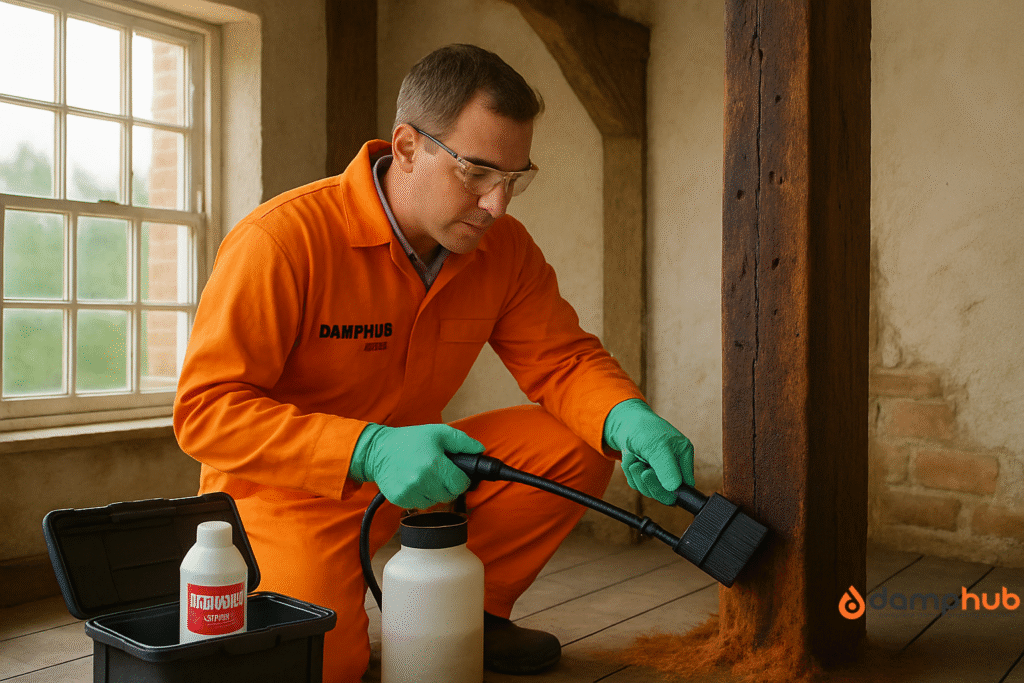
3. Sealing and Protecting Wood
Treating timber with preservative not only repels woodworm but also helps prevent rot.
- DIY preservative: £15–£30 per 5L tin.
- Professional preventative treatment: £200–£400 for a small‑to‑medium property.
4. Fixing Damp Problems
If you have rising damp, leaks, or condensation issues, woodworm prevention will only work temporarily.
- Minor damp fixes: £50–£150 for small repairs.
- Major damp proofing: £1,000+, but this protects both your timber and your home’s structure.
For a full breakdown, we have a dedicated post on damp proofing costs.
5. Storing Wood Correctly
If you have logs, old furniture, or spare timber, store them off the ground and away from your main home. Infested firewood or furniture can reintroduce woodworm.
6. Being Cautious with Second‑Hand Surprises
Buying antique or second‑hand wooden furniture is a common way of accidentally bringing woodworm into a home.
- Always inspect for fresh holes or dust before bringing it inside.
- If in doubt, treat it before use (£10–£20 DIY cost).
Cost Example — Prevention vs Repair
- Preventative measures for an average home: £150–£400.
- Treating a severe infestation with repairs: £1,000–£2,000+.
Vedict: Prevention wins every time.
Good to Know
Preventative treatment is most cost‑effective when done right after professional woodworm treatment. The timber is already accessible, so it’s cheaper to add a preventative coat at the same time than to book a separate visit later.
Do Insurance Policies Cover Woodworm Treatment Costs?
In most cases, the short answer is no. Standard home insurance policies in the UK don’t cover woodworm treatment because infestations are classed as a maintenance issue rather than an unexpected event. Insurers see it as the homeowner’s responsibility to keep the property in good condition.
Why Woodworm Isn’t Usually Covered
Insurance companies typically cover sudden and unforeseen damage — things like fire, flood, or accidental breakages.
Woodworm, however, works slowly over time. From the insurer’s point of view, if the infestation has been able to develop, it’s because the property wasn’t inspected or maintained regularly enough.
Rare Exceptions
There are a few situations where you might get help from your insurer:
- Optional add‑ons: Some premium policies offer cover for pest infestations, including wood‑boring insects. You’ll usually pay extra for this.
- New build warranties: If you’ve bought a new home with a structural warranty, it might include timber infestation cover for the first 10 years — but this is rare and usually very limited.
- Mis‑sold property: If you bought your home recently and the seller failed to disclose a known active infestation, you may have legal grounds for compensation (handled outside of standard home insurance).
What You Can Do
- Check your current policy wording for any mention of “pests” or “wood‑boring insects.”
- If you’re renewing your insurance, ask if pest cover can be added.
- Even if it costs more annually, it could be worth it if your property is high‑risk.
Pro Tip
If your insurer won’t cover woodworm treatment, they still might cover secondary damage it caused — for example, if weakened timber led to part of the ceiling collapsing. It’s worth asking the question before paying everything yourself.
Are Woodworm Treatment Costs Worth It in the Long Run?
In almost every case, yes — paying for woodworm treatment is worth it. That’s because untreated infestations can quietly eat through vital parts of your home’s structure, turning what might be a few hundred pounds of work today into thousands of pounds of repair bills later.
The Cost of Doing Nothing
Leaving an active infestation to run its course can cause:
- Severe structural damage to joists, beams, and floorboards.
- Safety hazards, such as floors giving way or roofs sagging.
- Lower property value, as surveyors will flag woodworm on reports.
- Repairs for advanced damage can easily hit £5,000–£15,000+, especially if major structural timber needs replacing.
Comparing Treatment Costs vs Damage Costs
- Small active infestation: £250–£350 to treat now.
- Left untreated for several years: repair bills of £2,000–£10,000+. The maths speaks for itself.
Protecting Property Value
Buyers and mortgage lenders see untreated woodworm as a red flag. Even if the infestation is no longer active, a lack of treatment records can slow or block a sale. Having a professional treatment certificate can give you peace of mind — and proof for future buyers.
Long‑Term Savings
Many professional treatments come with a 10–20-year guarantee. If the problem reappears during that time, the contractor will retreat free of charge. This means you pay once, and you’re covered for years.
Peace of Mind
While DIY can sometimes work for small infestations, having a professional job done means you know it’s handled properly — no guessing, no missed spots, no waking up in five years to the same problem.
Good to Know
If you treat woodworm early, you’re not just paying to kill beetles — you’re paying to protect your home from structural damage, expensive repairs, and reduced resale value. Think of it as an insurance policy you buy once.
Final Thought
Woodworm treatment isn’t a glamorous expense, but it’s one of those jobs where the longer you wait, the more you pay. The difference between a quick, contained treatment now and a major repair bill later can be thousands of pounds.
By understanding what drives costs — and knowing where you can save — you’re in a much stronger position to budget sensibly, avoid unnecessary extras, and make sure the work is done properly. Whether you tackle a tiny patch yourself or hire a professional for a full‑scale job, the key is acting early.
Answering Your Questions on Woodworm Treatrment Costs

Why do different brands charge different woodworm treatment costs?
It often comes down to more than just the size of your problem. Some companies use premium chemical formulas that last longer, others include more preparation work, or add follow‑up inspections in their price.
Bigger, well‑known brands may also carry higher overheads, which can push their prices up. On the flip side, smaller local firms might be cheaper, but you’ll want to check their experience and the quality of products they use — especially if you want the treatment to last.
Are there financing options for woodworm treatment?
Yes, many larger damp and timber specialists now offer staged payments or finance plans.
It’s worth asking, as even a mid‑sized job can run into four figures. Some firms will also let you spread the cost over a few months interest‑free.
If you’re considering finance, make sure the treatment guarantee still applies in full — you don’t want any fine‑print surprises.
Can I negotiate woodworm treatment costs?
Absolutely — within reason. Smaller, independent firms tend to have more wiggle room than big national brands.
You’re more likely to get a discount if you have multiple areas treated at once, or if you’re happy to book them during a quieter time of year.
Having two or three written quotes to hand can also help you negotiate from a stronger position.
How can I get the best value for money when treating woodworm?
Don’t just look at the cheapest number on the page. Check exactly what’s included: the type of treatment, any repairs, re‑inspection visits, and the guarantee period.
If one quote is cheaper but cuts corners on the prep work, you could end up paying twice. Also, make sure the surveyor is qualified and independent — spotting all affected areas up‑front means fewer nasty surprises later.
Will a longer guarantee make woodworm treatment more expensive?
Usually, yes — but it’s not always by much. A 20‑year guarantee may only add a small amount compared to a 10‑year one, depending on the firm.
The important part is whether the guarantee is actually worth anything: is it backed by an insurance policy?
Will the company still be around in ten years? Those details matter more than the number of years printed on a certificate.
Does paying more guarantee a longer‑lasting woodworm treatment?
Not necessarily. Higher prices can reflect better products and more thorough work, but it’s no guarantee the treatment will last longer.
The real key is correct diagnosis, skilled application, and ensuring the underlying cause (such as high timber moisture) is addressed.
A moderately‑priced but well‑done treatment will often outlast an expensive job done poorly.


